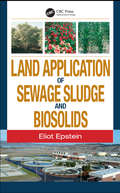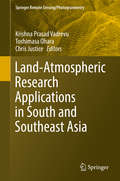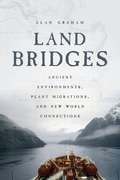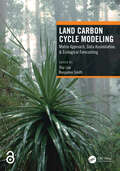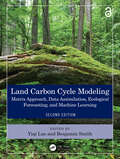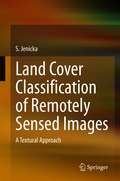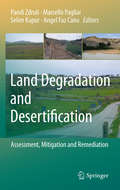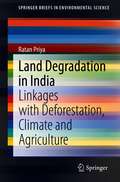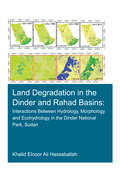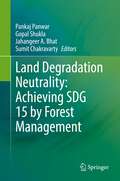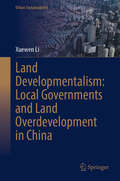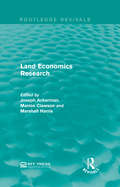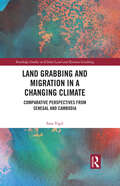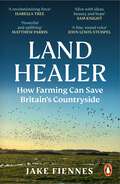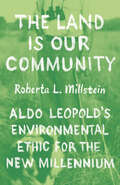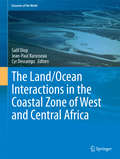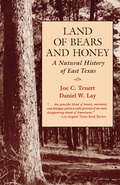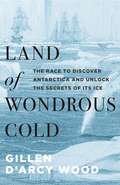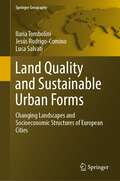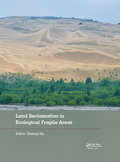- Table View
- List View
Land Application of Sewage Sludge and Biosolids
by Eliot EpsteinOver 50 percent of the 6,900 million dry tons of sewage sludge generated each year in the United States is land applied. The principal controversies surrounding the land application of biosolids involve heavy metals and pathogens. Land Application of Sewage Sludge and Biosolids is a comprehensive, scientific text providing a complete review of vari
Land-Atmospheric Research Applications in South and Southeast Asia (Springer Remote Sensing/photogrammetry Ser.)
by Krishna Prasad Vadrevu Toshimasa Ohara Chris JusticeThis edited volume sheds new light on the impact of rapid Land Use/Cover Changes (LU/CC) on greenhouse gases (GHG’s) and aerosol emissions in South and Southeast Asia. Several countries in South/Southeast Asia have the highest population growth rates in the world, which is the main cause for LU/CC. Conversion of dense forests to agricultural areas and then to residential and urban areas is most commonly observed in South/Southeast Asian countries with a significant release of GHG’s and aerosols. The book showcases several case studies on the use of remote sensing and geospatial technologies to quantify biomass burning and air pollution impacts, aerosol pollution, LU/CC, and impacts on ecosystem services. The book also includes articles on regional initiatives in research, capacity building, and training. The authors of this book are international experts in the field, and their contributions highlight significant drivers and impacts of air pollution in South/Southeast Asia. Readers will discover the latest tools and techniques, in particular, the use of satellite remote sensing and geospatial technologies for quantifying GHG’s, aerosols and pollution episodes in this region.
Land Bridges: Ancient Environments, Plant Migrations, and New World Connections
by Alan GrahamLand bridges are the causeways of biodiversity. When they form, organisms are introduced into a new patchwork of species and habitats, forever altering the ecosystems into which they flow; and when land bridges disappear or fracture, organisms are separated into reproductively isolated populations that can evolve independently. More than this, land bridges play a role in determining global climates through changes to moisture and heat transport and are also essential factors in the development of biogeographic patterns across geographically remote regions. In this book, paleobotanist Alan Graham traces the formation and disruption of key New World land bridges and describes the biotic, climatic, and biogeographic ramifications of these land masses’ changing formations over time. Looking at five land bridges, he explores their present geographic setting and climate, modern vegetation, indigenous peoples (with special attention to their impact on past and present vegetation), and geologic history. From the great Panamanian isthmus to the boreal connections across the North Atlantic and North Pacific Oceans that allowed exchange of organisms between North America, Europe, and Asia, Graham’s sweeping, one-hundred-million-year history offers new insight into the forces that shaped the life and land of the New World.
Land Carbon Cycle Modeling: Matrix Approach, Data Assimilation, & Ecological Forecasting
by Yiqi Luo Benjamin SmithCarbon moves through the atmosphere, through the oceans, onto land, and into ecosystems. This cycling has a large effect on climate – changing geographic patterns of rainfall and the frequency of extreme weather – and is altered as the use of fossil fuels adds carbon to the cycle. The dynamics of this global carbon cycling are largely predicted over broad spatial scales and long periods of time by Earth system models. This book addresses the crucial question of how to assess, evaluate, and estimate the potential impact of the additional carbon to the land carbon cycle. The contributors describe a set of new approaches to land carbon cycle modeling for better exploring ecological questions regarding changes in carbon cycling; employing data assimilation techniques for model improvement; and doing real- or near-time ecological forecasting for decision support. This book strives to balance theoretical considerations, technical details, and applications of ecosystem modeling for research, assessment, and crucial decision making. Key Features Helps readers understand, implement, and criticize land carbon cycle models Offers a new theoretical framework to understand transient dynamics of land carbon cycle Describes a suite of modeling skills – matrix approach to represent land carbon, nitrogen, and phosphorus cycles; data assimilation and machine learning to improve parameterization; and workflow systems to facilitate ecological forecasting Introduces a new set of techniques, such as semi-analytic spin-up (SASU), unified diagnostic system with a 1-3-5 scheme, traceability analysis, and benchmark analysis, for model evaluation and improvement Related Titles Isabel Ferrera, ed. Climate Change and the Oceanic Carbon Cycle: Variables and Consequences (ISBN 978-1-774-63669-5) Lal, R. et al., eds. Soil Processes and the Carbon Cycle (ISBN 978-0-8493-7441-8) Windham-Myers, L., et al., eds. A Blue Carbon Primer: The State of Coastal Wetland Carbon Science, Practice and Policy (ISBN 978-0-367-89352-1)
Land Carbon Cycle Modeling: Matrix Approach, Data Assimilation, Ecological Forecasting, and Machine Learning
by Benjamin Smith Yiqi LuoCarbon moves through the atmosphere, through the oceans, onto land, and into ecosystems. This cycling has a large effect on climate – changing geographic patterns of rainfall and the frequency of extreme weather – and is altered as the use of fossil fuels adds carbon to the cycle. The dynamics of this global carbon cycling are largely predicted over broad spatial scales and long periods of time by Earth system models. This book addresses the crucial question of how to assess, evaluate, and estimate the potential impact of the additional carbon to the land carbon cycle. The contributors describe a set of new approaches to land carbon cycle modeling for better exploring ecological questions regarding changes in carbon cycling; employing data assimilation techniques for model improvement; doing real- or near-time ecological forecasting for decision support; and combining newly available machine learning techniques with process-based models to improve prediction of the land carbon cycle under climate change. This new edition includes seven new chapters: machine learning and its applications to carbon cycle research (five chapters); principles underlying carbon dioxide removal from the atmosphere, contemporary active research and management issues (one chapter); and community infrastructure for ecological forecasting (one chapter).Key Features Helps readers understand, implement, and criticize land carbon cycle models Offers a new theoretical framework to understand transient dynamics of the land carbon cycle Describes a suite of modeling skills – matrix approach to represent land carbon, nitrogen, and phosphorus cycles; data assimilation and machine learning to improve parameterization; and workflow systems to facilitate ecological forecasting Introduces a new set of techniques, such as semi-analytic spin-up (SASU), unified diagnostic system with a 1-3-5 scheme, traceability analysis, and benchmark analysis, and PROcess-guided machine learning and DAta-driven modeling (PRODA) for model evaluation and improvement Reorganized from the first edition with seven new chapters added Strives to balance theoretical considerations, technical details, and applications of ecosystem modeling for research, assessment, and crucial decision-making
Land Cover Classification of Remotely Sensed Images: A Textural Approach
by S. JenickaThe book introduces two domains namely Remote Sensing and Digital Image Processing. It discusses remote sensing, texture, classifiers, and procedures for performing the texture-based segmentation and land cover classification. The first chapter discusses the important terminologies in remote sensing, basics of land cover classification, types of remotely sensed images and their characteristics. The second chapter introduces the texture and a detailed literature survey citing papers related to texture analysis and image processing. The third chapter describes basic texture models for gray level images and multivariate texture models for color or remotely sensed images with relevant Matlab source codes. The fourth chapter focuses on texture-based classification and texture-based segmentation. The Matlab source codes for performing supervised texture based segmentation using basic texture models and minimum distance classifier are listed. The fifth chapter describes supervised and unsupervised classifiers. The experimental results obtained using a basic texture model (Uniform Local Binary Pattern) with the classifiers described earlier are discussed through the relevant Matlab source codes. The sixth chapter describes land cover classification procedure using multivariate (statistical and spectral) texture models and minimum distance classifier with Matlab source codes. A few performance metrics are also explained. The seventh chapter explains how texture based segmentation and land cover classification are performed using the hidden Markov model with relevant Matlab source codes. The eighth chapter gives an overview of spatial data analysis and other existing land cover classification methods. The ninth chapter addresses the research issues and challenges associated with land cover classification using textural approaches. This book is useful for undergraduates in Computer Science and Civil Engineering and postgraduates who plan to do research or project work in digital image processing. The book can serve as a guide to those who narrow down their research to processing remotely sensed images. It addresses a wide range of texture models and classifiers. The book not only guides but aids the reader in implementing the concepts through the Matlab source codes listed. In short, the book will be a valuable resource for growing academicians to gain expertise in their area of specialization and students who aim at gaining in-depth knowledge through practical implementations. The exercises given under texture based segmentation (excluding land cover classification exercises) can serve as lab exercises for the undergraduate students who learn texture based image processing.
Land Degradation and Desertification: Assessment, Mitigation and Remediation
by Angel Faz Cano Marcello Pagliai Pandi Zdruli Selim KapurLand Degradation and Desertification: Assessment, Mitigation, and Remediation reports research results in sustainable land management and land degradation status and mitigation in 36 countries around the world. It includes background papers with continental and international perspectives dealing with land degradation and desertification studies. The book assembles various topics of interest for a large audience. They include carbon sequestration and stocks, modern techniques to trace the trends of land degradation, traditional and modern approaches of resource-base conservation, soil fertility management, reforestation, rangeland rehabilitation, land use planning, GIS techniques in desertification risk cartography, participatory ecosystem management, policy analyses and possible plans for action. Various climatic domains in Africa, Asia, Europe and The Americas are covered. The book will be of interest to a variety of environmental scientists, agronomists, national and international policy makers and a number of organizations dealing with sustainable management of natural resources.
Land Degradation in India: Linkages with Deforestation, Climate and Agriculture (SpringerBriefs in Environmental Science)
by Ratan PriyaThis book discusses land degradation in India using statistical tools such as Principal Component Analysis (PCA) and Regression Analysis (RA), and uses statistical analyses and graphical representations of the causal relationship between land degradation and land productivity to determine linkages with deforestation, climate change and agricultural productivity. While most studies of land degradation in India focus on economic outcomes and physical processes at macro and micro levels, this study addresses land degradation at the meso-level to fill in this gap and provide up-to-date information on often overlooked factors associated with land degradation issues using the latest available data. Districts in the study were selected by land degradation intensity, forming an index of the severity of land degradation in the area, with a focus on gullied lands, soil salinity/alkalinity and open and dense scrubs as indicators. Though the study areas are in India, researchers, policy makers and students around the world will be able to learn from these inputs regarding land degradation to address various challenges associated with sustainable land management and agricultural productivity.
Land Degradation in the Dinder and Rahad Basins: Interactions Between Hydrology, Morphology and Ecohydrology in the Dinder National Park, Sudan (IHE Delft PhD Thesis Series)
by Khalid Elnoor HassaballahThe spatial and temporal variability of the hydro-climate as well as land use and land cover (LULC) changes are among the most challenging problems facing water resources management. Understanding the interaction between climate variability, land use and land cover changes and their links to hydrology, river morphology and ecohydrology in the Dinder and Rahad basins in Sudan is confronted by the lack of climatic, hydrological and ecological data. This book investigated the impacts of land degradation on the Dinder and Rahad hydrology and morphology, and interlinkage to the ecohydrological system of the Dinder National Park (DNP) in Sudan. It used an ensemble of techniques to improve our understanding of the hydrological processes and LULC changes in these basins. This included long-term trend analysis of hydroclimatic variables, LULC changes analysis, field measurements, rainfall-runoff modelling, hydrodynamic and morphological modelling of the Dinder river and its floodplain, with special focus on the Mayas wetlands. Moreover, this research is the first study to investigate the eco-hydrology of the DNP. It is expected that the results of the study will be beneficial to all stakeholders concerned and support decision-making processes for better management of water resources and ecosystem conservation in the area and possibly beyond.
Land Degradation Neutrality: Achieving SDG 15 by Forest Management
by Pankaj Panwar Gopal Shukla Jahangeer A. Bhat Sumit ChakravartyThis edited book covers all aspects of forest deforestation and degradation in detail and their link to land degradation. Poor natural resource management is often a contributory factor in the depletion of resources particularly like degradation of land which hinders the goals to achieve land degradation neutrality (LDN). Sustainable Development Goal (SDG) target 15.3 states: “By 2030, combat desertification, restore degraded land and soil, including land affected by desertification, drought, and floods, and strive to achieve a land degradation-neutral world.” To achieve the set goals a comprehensive multidirectional approach is required involving policymakers, field functionaries, researchers, and above all educators. The book compiles the field experiences and wisdom of some of the best researchers and authors working in the field of land degradations for quite a long time. The objective of the book is to disseminate the status of land degradation, the importance of achieving land degradation and share success stories of reclaiming Land degradation, and suggests means and ways of achieving land degradation neutrality. This book act as a repository of knowledge on Land degradation neutrality for students, researchers and practitioners, and policy planners.
Land Developmentalism: Local Governments and Land Overdevelopment in China (Urban Sustainability)
by Xuewen LiThis book examines the strategies adopted by local governments to obtain excess construction land quotas in the face of the central government’s strict land management system. It applies game theory, principal-agent theory, collective action theory, and competition and collusion theory to analyze the trade-offs and constraints faced by local governments under the existing institutional framework. It also empirically tests the imitative competitive strategy of land violation and the institutional collusion strategy of land development rights trading using spatial panel model and Tobit model. The book reveals the internal mechanism behind local governments’ simultaneous adoption of competitive and collusive strategies in pursuing local interests and economic growth. It also shows how local governments’ land violations have significant strategic characteristics in time and space, and how economic development gap, resource endowment gap, and human network relationship influence their collusion formation in land development rights trading. This book is a valuable contribution to the literature on land management, local governance, and political economy in China. It is suitable for scholars, students, policy makers, and practitioners who are interested in understanding the complex dynamics of land development in China. The book is written in an accessible and engaging style, with clear explanations of theoretical concepts and empirical methods.
Land Economics Research: Papers Presented At A Symposium Held At Lincoln, Nebraska, June 16-23, 1961 (Routledge Revivals)
by Joseph Ackerman Marion Clawson Marshall HarrisOriginally published in 1962, Land Economics Research brings together papers presented at a symposium in Nebraska in 1961 which deal with ideas, theories and suggestions in land economics to encourage problem-solving in American land issues. This report draws on all types of land, all situations and all economics problems related to land issues. This title will be of interest to students of Environmental Studies and Economics as well as professionals.
Land, Food And Rural Development In North Africa
by M. Riad El-GhonemyThis study of rural development in six North African nations addresses the issues surrounding poverty and landlessness. Providing an Islamic perspective on policy-making, the author describes the influence of Islam on development in these countries, and stresses the Islamic religious and moral revival as a major factor in policy-making toward reduc
Land Grabbing and Migration in a Changing Climate: Comparative Perspectives from Senegal and Cambodia (Routledge Studies in Global Land and Resource Grabbing)
by Sara VigilThis book provides a theoretical and empirical examination of the links between environmental change, land grabbing, and migration, drawing on research conducted in Senegal and Cambodia. While the impacts of environmental change on migration and of environmental discourses on land grabs have received increased attention, the role of both environmental and migration narratives in shaping migration by modifying access to natural resources has remained under-explored. Using a variegated geopolitical ecology framework and a comparative global ethnographic approach, this book analyses the power of mainstream adaptation and security frameworks and how they impact the lives of marginalised and vulnerable communities in Senegal and Cambodia. Findings across the cases show how environmental and migration narratives, linked to adaptation and security discourses, have been deployed advertently or inadvertently to justify land capture, leading to interventions that often increase, rather than alleviate, the very pressures that they intend to address. The interrelations between these issues are inherent to the tensions that exist, in different contexts and at different times, between capital accumulation and political legitimation. The findings of the book point to the urgency for researchers and policymakers to address the structural causes, and not the symptoms, of both environmental destruction and forced migration. It shows how acting upon environmental change, land grabs, and migration in isolated or binary manners can increase, rather than alleviate, pressures on those most socio-environmentally vulnerable. This book will be of interest to students, scholars, and practitioners working on the topics of land and resource grabbing and environmental change and migration. The book will also be of interest to those analysing political ecology transitions in Africa and Asia, as well as to those interested in novel theoretical and methodological frameworks.
Land Healer: How Farming Can Save Britain’s Countryside
by Jake Fiennes'Jake Fiennes is changing the face of farming in Britain... a revolutionising force' Isabella TreeOur relationship with our land is broken: we must heal it.Jake Fiennes is on a mission to change the face of the English countryside. As Conservation Manager at Holkham in Norfolk, one of the country's largest historic country estates, his radical habitat restoration and agricultural work has nurtured its species and risen its crop yields - bringing back wetlands, hedgerows, birds and butterflies over 25,000 acres of land.But this isn't rewilding - there is no 'wild' in Britain anymore. Mass farming, crop science and industrial chemicals have destroyed the majority of our natural landscape and wildlife over the last century. Land Healer is the story of Fiennes's ambition to bring back our flora and fauna - by reclaiming our traditions and trialling new experiments which could restore our symbiosis with our land, and save our shared future.Following the farming year and the natural cycle of the seasons, Land Healer chronicles a life of conservation lived at the edges, and is a manifesto for rethinking our relationship with the natural world before it's too late.
The Land Is Our Community: Aldo Leopold’s Environmental Ethic for the New Millennium
by Roberta L. MillsteinA contemporary defense of conservationist Aldo Leopold’s vision for human interaction with the environment. Informed by his experiences as a hunter, forester, wildlife manager, ecologist, conservationist, and professor, Aldo Leopold developed a view he called the land ethic. In a classic essay, published posthumously in A Sand County Almanac, Leopold advocated for an expansion of our ethical obligations beyond the purely human to include what he variously termed the “land community” or the “biotic community”—communities of interdependent humans, nonhuman animals, plants, soils, and waters, understood collectively. This philosophy has been extremely influential in environmental ethics as well as conservation biology and related fields. Using an approach grounded in environmental ethics and the history and philosophy of science, Roberta L. Millstein reexamines Leopold’s land ethic in light of contemporary ecology. Despite the enormous influence of the land ethic, it has sometimes been dismissed as either empirically out of date or ethically flawed. Millstein argues that these dismissals are based on problematic readings of Leopold’s ideas. In this book, she provides new interpretations of the central concepts underlying the land ethic: interdependence, land community, and land health. She also offers a fresh take on of his argument for extending our ethics to include land communities as well as Leopold-inspired guidelines for how the land ethic can steer conservation and restoration policy.
The Land/Ocean Interactions in the Coastal Zone of West and Central Africa
by Salif Diop Jean-Paul Barusseau Cyr DescampsAlthough the main focus of this book is on the estuaries, its scope goes well beyond this particular coastal feature. Indeed, the estuary can only be considered as part of the life cycle of the entire river and the marine area it feeds into: an area particularly subject to human and natural pressures. The main estuaries and deltas of West and Central Africa region provide a variety of goods and services to its coastal population. The most important of them are related to critical fish habitat, wood and charcoal from mangroves, as well as space for agriculture, aquaculture, urban development, tourism and transport. Particular emphasis has been made in this book on mangroves that play a significant role in terms of flood control, groundwater replenishment, coastline stabilization and protection against storms. They also retain sediments and nutrients, purify water, and provide critical carbon storage. Such hydrological and ecological functions explain the focus on serving mangrove ecosystems and the nearby communities, which draw significant income from fishing, rice production, tourism, salt extraction and other activities such as harvesting honey and medicinal plants, hence the need for preserving mangrove ecosystems to ensure sustainability of the estuaries and deltas of West and Central Africa region. The book has a foreword by Mr. Achim Steiner, United Nations Under-Secretary General and Executive Director of UNEP who is stating that credible and up-to-date information is essential for the public at large but more specifically for scientists, researchers, managers, decision-makers all working together in order to safeguard, protect and sustainably manage estuaries, deltas and lagoons, and the coastal and ocean waters of Western and Central Africa.
Land of Bears and Honey: A Natural History of East Texas
by Joe C. Truett Daniel W. LayThis award-winning &“gem&” of a conservation classic tells the story of the land, wildlife, and ecology of East Texas (Quarterly Review of Biology).Winner of the Ottis Lock Endowment Award from the East Texas Historical Association; the Texas Literary Festival Award for Nonfiction from the Southwestern Booksellers Association & Dallas Times Herald; and the Annual Publication Award, Texas Chapter of the Wildlife Society As hickory groves and fox squirrels began to vanish from the East Texas landscape in the second half of the twentieth century, two biologists who specialized in wildlife and endangered species began work on Land of Bears and Honey. Their purpose was not only to eulogize what was lost, but to encourage us to save what we still can. The result is an &“elegant chronicle of the natural history of a once-rich area [that] will appeal strongly to birders, ecologists, to anyone who enjoys the outdoors&” (Publishers Weekly). &“This deceptively slender volume is three things: a how-to-book, an aesthetic feast and a moral tale.&” —Dallas Morning News &“To compare the style and content of this little book to that of the late Aldo Leopold is indeed high praise, yet the reviewer finds this comparison valid.&” —Quarterly Review of Biology &“In Land of Bears and Honey, East Texans have their own regional Walden, written with keen historical perspectives, literary style, and deep respect for the land.&” —East Texas Historical Journal &“This graceful blend of history, narrative and dialogue paints a noble portrait of one more disappearing chunk of Americana.&” —Los Angeles Times Book Review
Land of Bears and Honey: A Natural History of East Texas
by Joe C. Truett Daniel W. LayThis award-winning &“gem&” of a conservation classic tells the story of the land, wildlife, and ecology of East Texas (Quarterly Review of Biology).Winner of the Ottis Lock Endowment Award from the East Texas Historical Association; the Texas Literary Festival Award for Nonfiction from the Southwestern Booksellers Association & Dallas Times Herald; and the Annual Publication Award, Texas Chapter of the Wildlife Society As hickory groves and fox squirrels began to vanish from the East Texas landscape in the second half of the twentieth century, two biologists who specialized in wildlife and endangered species began work on Land of Bears and Honey. Their purpose was not only to eulogize what was lost, but to encourage us to save what we still can. The result is an &“elegant chronicle of the natural history of a once-rich area [that] will appeal strongly to birders, ecologists, to anyone who enjoys the outdoors&” (Publishers Weekly). &“This deceptively slender volume is three things: a how-to-book, an aesthetic feast and a moral tale.&” —Dallas Morning News &“To compare the style and content of this little book to that of the late Aldo Leopold is indeed high praise, yet the reviewer finds this comparison valid.&” —Quarterly Review of Biology &“In Land of Bears and Honey, East Texans have their own regional Walden, written with keen historical perspectives, literary style, and deep respect for the land.&” —East Texas Historical Journal &“This graceful blend of history, narrative and dialogue paints a noble portrait of one more disappearing chunk of Americana.&” —Los Angeles Times Book Review
Land of Wondrous Cold: The Race to Discover Antarctica and Unlock the Secrets of Its Ice
by Gillen D’Arcy WoodA gripping history of the polar continent, from the great discoveries of the nineteenth century to modern scientific breakthroughsAntarctica, the ice kingdom hosting the South Pole, looms large in the human imagination. The secrets of this vast frozen desert have long tempted explorers, but its brutal climate and glacial shores notoriously resist human intrusion. Land of Wondrous Cold tells a gripping story of the pioneering nineteenth-century voyages, when British, French, and American commanders raced to penetrate Antarctica’s glacial rim for unknown lands beyond. These intrepid Victorian explorers—James Ross, Dumont D’Urville, and Charles Wilkes—laid the foundation for our current understanding of Terra Australis Incognita.Today, the white continent poses new challenges, as scientists race to uncover Earth’s climate history, which is recorded in the south polar ice and ocean floor, and to monitor the increasing instability of the Antarctic ice cap, which threatens to inundate coastal cities worldwide. Interweaving the breakthrough research of the modern Ocean Drilling Program with the dramatic discovery tales of their Victorian forerunners, Gillen D’Arcy Wood describes Antarctica’s role in a planetary drama of plate tectonics, climate change, and species evolution stretching back more than thirty million years. An original, multifaceted portrait of the polar continent emerges, illuminating our profound connection to Antarctica in its past, present, and future incarnations.A deep-time history of monumental scale, Land of Wondrous Cold brings the remotest of worlds within close reach—an Antarctica vital to both planetary history and human fortunes.
Land Quality and Sustainable Urban Forms: Changing Landscapes and Socioeconomic Structures of European Cities (Springer Geography)
by Ilaria Tombolini Jesús Rodrigo-Comino Luca SalvatiIn the panorama of studies related to the ability of lands to support both natural processes and agricultural production activities, this research introduces a still unexplored or under-studied theme which is that of the relationship between urban sprawl in its various forms and land quality.The first part of the book is dedicated to the motivations and the theoretical premises from which the research originates, connected to the concept of land and those of sustainable urban form. The second part concerns the complex path towards a sustainable use of land, both in terms of institutional and regulatory measures, and in terms of knowledge and understanding of soil degradation processes. This research focuses on the Mediterranean area which is discussed in more detail in the third part. In this part of Europe we try to establish relationships between settlement dynamics and land quality: here fragile ecosystems are diffused both from a biological point of view. physical as well as socio-economic, here we find landscapes that are particularly sensitive to land degradation processes (subject to land degradation, considered the antipodes of land quality) and which in recent decades have been particularly affected by anthropic pressure.In the fourth part, an analysis is presented concerning 76 metropolitan areas representative of southern Europe. The methodology used in this analysis is based on the relationship that exists between soil sealing (or soil waterproofing) and land degradation (or land degradation) aimed at an interpretation, at the metropolitan scale, of how in southern Europe the pattern of Urbanization (compact, dispersive, intermediate) affects the land's ability to support both natural processes and agricultural production activities in a diversified way. In particular, the data on land quality and data on land use were considered together in order to analyze the processes of urban growth and the occupation of productive land for a very large area that includes Greece, France, Italy, Spain, Portugal and some parts of the Adriatic coast.There is still a long way to go, in terms of sharing, integration and definition of strategies aimed at achieving certain targets. A necessary and innovative look towards land quality could help to consider the protection of the soil as a whole, even at the planning level.
Land Reclamation in Ecological Fragile Areas: Proceedings of the 2nd International Symposium on Land Reclamation and Ecological Restoration (LRER 2017), October 20-23, 2017, Beijing, PR China
by Zhenqi HuLand Reclamation in Ecological Fragile Areas contains the proceedings of the 2nd International Symposium on Land Reclamation and Ecological Restoration (LRER 2017, Xi’an, China, 20-23 October 2017). The contributions cover a wide range of topics: • Mining impact on environment• Monitoring, prediction and assessment of mining impact on land environment• Mining methods and measurements to minimize the land and environment impact• Mining and reclamation policies, regulations and standard • AMD treatment• Soil and landscape reconstruction• Revegetation and biodiversity protection• Subsidence land reclamation and ecological restoration• Surface mined land reclamation and ecological restoration• Solid wastes management, waste dump and tailings pond restoration• Case study• Abandoned mine land reclamation and ecological restoration• Contaminated land remediation• Reclaimed land monitoring and evaluation• Land reclamation supervision• Products and industrialization• Education, technology transfer and international cooperation of mine land reclamation• “The Belt and Road Initiative” and mine land restoration Land Reclamation in Ecological Fragile Areas will be of interest to engineers,scientists, consultants, government officials and students in this area.
Land Remediation and Management: Bioengineering Strategies
by Hemen Sarma Sanket JoshiThis edited book deals with land regeneration and management using living organisms for a sustainable future. It brings together the latest developments made by leading biotechnologists, bioengineers and environmental scientists in the area of land remediation. The chapters cover different aspects of soil's conventional and emerging pollutants (synthetic or naturally occurring chemicals). Global population is rapidly affected by this catastrophic situation, industrialization and overuse of chemical compounds. There are currently many bioengineering strategies used to eliminate these dangerous chemicals. In this book, the chapters present the current evidence and comprehensive studies that may be useful for reader. It provides a comprehensive text thereby filling the gap in the literature. The contents of the book further deliver a good understanding of emerging environmental contaminants and their sustainable remediation through the use of bioengineering tools and techniques.This book is of interest to industry experts, researchers, academicians in bioengineering and biomedical sciences, graduates and undergraduates in Biotechnology, Microbiology, Environmental Sciences, Health, Clinical and Pharmaceutical Sciences. It is also a useful read for national and international agricultural scientists and policy makers.
Land Remote Sensing and Global Environmental Change
by Michael J. Abrams Christopher O. Justice Bhaskar RamachandranLand Remote Sensing and Global Environmental Change: The Science of ASTER and MODIS is an edited compendium of contributions dealing with ASTER and MODIS satellite sensors aboard NASA's Terra and Aqua platforms launched as part of the Earth Observing System fleet in 1999 and 2002 respectively. This volume is divided into six sections. The first three sections provide insights into the history, philosophy, and evolution of the EOS, ASTER and MODIS instrument designs and calibration mechanisms, and the data systems components used to manage and provide the science data and derived products. The latter three sections exclusively deal with ASTER and MODIS data products and their applications, and the future of these two classes of remotely sensed observations.

